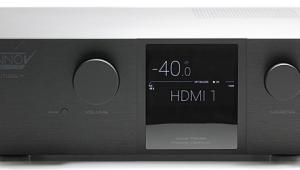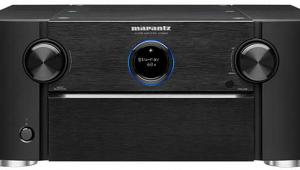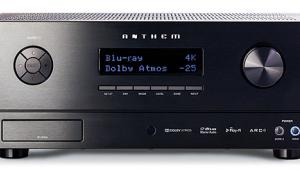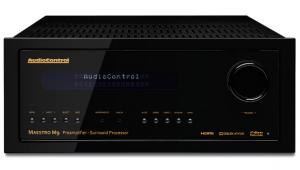Adcom GTP-880 Pre/Pro & GFA-7607 Amplifier
In case you hadn't noticed, the bell has rung, and the blows are flying in the $3,000-to-$5,000 range for electronics systems (i.e., preamplification, processing, and amplification). It's easy to characterize this as a melee between receivers and separates, which is a key component of what we're seeing at this price level. Receivers are sounding better and getting more expensive; separates are getting more user-friendly, offering more features, and dropping in price.
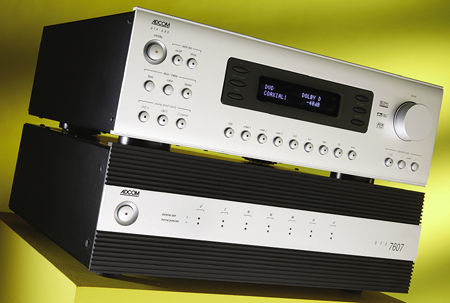
Worlds are colliding as these once-distant categories encroach on one another's territory.
While the receivers-versus-separates bout may be the main event, there's plenty on the undercard, as well—particularly among separates combinations in this price range. There are more entry-level separates systems now than there have ever been, and end-users will only benefit as the competition among them intensifies.
Adcom, no stranger to value in the high-end, weighs in with multiple contenders in the entry-level separates category, including the new GTP-880 pre/pro ($2,400) and the GFA-7607 amplifier ($1,500). At $3,900 for the pair, this is one of the least expensive separates combinations you'll find—and it's not even Adcom's least expensive combination (the older GTP-830 pre/pro is a few hundred dollars less than the GTP-880, but it lacks some of the latter's benefits). Despite its friendlier price tag, the GTP-880/GFA-7607 combo is still well stocked in the aspects that separate contenders as the quality level rises.

The GTP-880 is a 7.1-channel design equipped with all of the processing headliners except THX. Dolby EX, 5.1, and Pro Logic II are here, along with DTS ES (Discrete and Matrix), 5.1, and Neo:6. Adcom has added their proprietary 7.1m(2) format, which uses matrix techniques to derive a rear channel from a 5.1-channel source (movies or music). The front panel offers several direct-access controls and a good-sized display.
The rear panel houses a comprehensive array of connections, including multichannel inputs via a DB-25 input or RCA jacks. I'm not sure why Adcom chose to dub the former the SACD input and the latter the DVD-Audio input, but, needless to say, either format will work with either input. A handy analog bass-management system for these inputs, which is entirely separate from the digital system, is toggled via a rear-panel switch. It offers three options: high-pass filtering for the mains and low-pass filtering for the sub (80 hertz, 12 decibels per octave); high-pass filtering off but low-pass filtering on (allowing bass from the sub and full-range main speakers); or full bypass.
The rear panel also offers six digital inputs (three optical, three coax) and an output of each variety, as well as eight analog stereo inputs and three outputs, including one for zone two. Video gets three component inputs and an output, with BNC connectors. I would've liked to see RCA jacks on an entry-level model, but BNC cables are easy enough to find, as are adapters (although this should be a short-term solution). There's also five S-video and composite inputs and two outputs of each. Control connections include an RS-232 jack and 12-volt triggers and IR inputs for both zones.
 The GFA-7607 is a relatively compact, seven-channel design rated at 125 watts per channel—more than enough to compete with the receivers and multichannel amplifiers in this price range. All channels share a hefty-looking toroidal transformer, but each gets its own power-supply components beyond that. The rear panel is appropriately simple: five-way binding posts and RCA inputs for each channel. There's no balanced inputs or bridging capability, but I don't expect either in the entry-level arena. The front panel is a slick silver-and-black combination with dual LEDs for each channel to signal distortion or thermal-protection anomalies. The thermal-protection circuit kicks in whenever a heatsink reaches 85 degrees Centigrade. The distortion-alert circuit monitors all forms of non-linear distortion and alerts you when levels pass 1 percent, regardless of the speakers' impedance, voltage/current phase angle, or reactance.
The GFA-7607 is a relatively compact, seven-channel design rated at 125 watts per channel—more than enough to compete with the receivers and multichannel amplifiers in this price range. All channels share a hefty-looking toroidal transformer, but each gets its own power-supply components beyond that. The rear panel is appropriately simple: five-way binding posts and RCA inputs for each channel. There's no balanced inputs or bridging capability, but I don't expect either in the entry-level arena. The front panel is a slick silver-and-black combination with dual LEDs for each channel to signal distortion or thermal-protection anomalies. The thermal-protection circuit kicks in whenever a heatsink reaches 85 degrees Centigrade. The distortion-alert circuit monitors all forms of non-linear distortion and alerts you when levels pass 1 percent, regardless of the speakers' impedance, voltage/current phase angle, or reactance.
Setup couldn't be much easier, which is good news for a system that has to compete with receivers and other user-friendly separates. You have to run six or eight extra cables and clear out another spot in the rack, but, in all other ways, this combination is as simple to set up as any receiver, if not more so. A good onscreen interface, a comprehensive manual, and a first-rate remote (based on the well-known Home Theater Master design) greatly facilitate the process. There aren't a lot of tweaks to individual sound modes and other high-end tricks, but there rarely are in this price range, where simplicity and a focus on the less-esoteric controls are the main design goals. I set up the Adcoms with an Energy Veritas 2.4 speaker system and a Marantz DV8300 universal disc player and was up and running in under 30 minutes.
The GTP-880/GFA-7607 combination introduced itself with a sharp, clean presentation of two-channel music. Dynamic range was obvious with big cuts like "Lindekirche Berlin" from the second Burmester collection, as was the GFA-7607's ability to handle some pressure. I immediately liked the control it maintained over the 2.4's dual woofers, keeping them tight and well defined but also giving them some room to thump when necessary. I noted some occasional sizzle on the top end of the frequency range, mainly with more-intense cymbal strikes and harmonicas, but nothing that isn't generally par for the course in this price range. This was obviously much more of an issue with older material and newer material whose production values aren't what they should be. Well-recorded material consistently generated warm, stable upper frequencies. Midrange performance was smooth and fluid, with a naturalness to vocals that caught my ear on a number of occasions. I also liked the way this combination handled strings, particularly the signature fiddle track of Ralph Stanley's "Two Coats" (Cry from the Cross, Rebel Records). There was a richness and resolution of harmonic structure here that was highly impressive.
The midrange—and most everything else—only improved when I switched over to quality high-resolution, multichannel tracks. Vocals took on a sense of body that so much 16-bit/44.1-kilohertz material seems to lack. I confirmed that the GTP-880 was doing a first-rate job of passing analog signals through untouched by temporarily running the Marantz player straight into the GFA-7607. The amp's dynamic range and composure were evident again. It did a nice job of quickly and cleanly shifting gears with Pink Floyd's Dark Side of the Moon SACD (Capitol), which asks an amp to go from zero to 60 in a hurry. Harder sounds, such as the alarm-clock assault in "Time," were no more grating than they're supposed to be, yet there's no artificial sweetening to this Adcom combination, either—and there shouldn't be. While I'm not altogether convinced that 7.1 channels are necessary for movies, let alone music, I did give the 7.1m(2) mode a try with both SACD and DVD-Audio material and generally liked what I heard. The effect is appropriately subtle, giving an extra sense of fill to the rear of the room without calling attention to itself. It was more effective with some tracks than others, but it does provide yet another interesting option in the playback mix.
The first thing to jump out at me with soundtrack demos was the staging that the Adcom combination delivered. This wasn't because it blew me away with raw size and power the way a 300-watts-per-channel amplifier that costs more than both of these units together usually will. Depth and presence are more than adequate here, especially when compared with the receiver and entry-level multichannel-amp competition. It was the soundstage's definition and stability that really caught my attention. Even with dense, effects-heavy scenes like chapter 1 of Lord of the Rings: The Two Towers, the GFA-7607 never showed signs of fatigue until the volume level passed well beyond the normal range. I can't say the same about many of the receivers, high-enders included, that I've run this track through. The GFA-7607 continually proved that it could take some abuse, but without becoming overly aggressive or sloppy, either. Even with large explosions and other demands for a lot of quick power, there was clear evidence of a delicate touch.
There's no doubt that Adcom has a solid contender in the middleweight class with the GTP-880 and GFA-7607. As one of the least expensive separates combinations you can buy, price is obviously in their favor. The best thing I can say about them is that they primarily do what quality electronics are supposed to do—get out of the way and let the source material speak for itself. Couple this with the fact that they're considerably easy to use, well covered in the features department, and even have an aesthetic flair to them, and it's easy to see why the GTP-880 and GFA-7607 won't have to back down from any challenges in the growing range of midpriced electronics systems.

GTP-880 Pre/Pro $2,400
GFA-7607 Amplifier $1,500
- Log in or register to post comments

